密码学与网络安全-附录F
密码编码学与网络安全pdf

密码编码学与网络安全pdf密码编码学是研究如何在通信中保护信息安全的学科。
网络安全是保护计算机网络系统免受未经授权的访问、损坏或者攻击的过程。
这两个领域有一定的关联,因为密码编码是网络安全的重要组成部分。
密码编码学是关于密码学的研究,主要包括对称密码和非对称密码。
对称密码意味着发送方和接收方使用同样的密钥进行加密和解密。
非对称密码则使用一对密钥,其中一个是公钥,用于加密信息,而另一个是私钥,用于解密信息。
密码编码学的目标是确保加密的信息只能被授权的人解密而不被未经授权的人获取。
为了达到这个目标,研究者们通过研究密码算法的方法和强度,以及密钥管理和分发的策略,来提供可靠的安全性。
网络安全是指保护计算机网络不受未经授权的访问、损坏或攻击的过程。
网络安全的目标是确保网络以及其中的数据和系统的完整性、保密性和可用性。
为了实现网络安全,一些技术和策略应用于网络的不同层面。
例如,防火墙可以帮助过滤和阻止未经授权的网络流量,入侵检测系统可以监测和报告潜在的攻击,安全认证机制可以验证用户的身份,数据加密可以保护数据的保密性,等等。
网络安全和密码编码学是密切相关的领域。
密码编码学的研究为网络安全提供了加密和解密通信的方法。
密码编码学的研究结果可以应用于网络通信的加密保护。
例如,对称密码算法可以用于确保在网络中传输的数据的机密性,而非对称密码算法可以用于实现网络的身份验证。
此外,网络安全中的一些技术和策略,如公钥基础设施和密钥管理,是密码编码学研究的关键组成部分。
总而言之,密码编码学与网络安全密切相关,互相补充。
密码编码学提供了加密和解密通信的方法,而网络安全则应用这些方法来保护计算机网络系统免受未经授权的访问、损坏或攻击。
这两个领域都是为了确保信息和系统的安全性,以应对日益增长的网络威胁。
网络安全课件-密码学篇

3
区块链技术
运用区块链的去中心化和不可篡改性,增强密码学的安全性。
安全意识教育
社交工程
提高员工对社交工程攻击和 钓鱼邮件的警惕。
弱密码
教育员工创建和使用强密码 来保护个人和组织的数据。
数据备份
加强数据备份意识,及时备 份重要数据,减少数据丢失 的风险。
总结
1 密码学是网络安全的基 2 不断学习和更新知识
网络通信
保护在线传输的敏感信息,如网络银行和电 子商务。
数据存储
加密云存储和数据库,保护用户隐私。
数字货币
确保交易的安全和匿名性,如比特币和以太 坊。
身份认证
使用数字签名验证用户身份和文件完整性。
密码学的未来展望
1
Hale Waihona Puke 量子密码学利用量子力学原理设计的加密算法,抵抗量子计算机的破解。
2
多因素认证
结合密码、生物特征和硬件设备等多种因素进行身份验证。
3 密钥存储
加密保存密钥,确保只有授权用户可以访问。
4 密钥更新
定期更新密钥以提高系统安全性。
数据保护
数据加密
使用加密算法对重要数据进行 保护,确保机密性。
访问控制
限制用户对敏感数据的访问权 限,确保数据的完整性和可用 性。
备份和恢复
定期备份数据,并建立可靠的 恢复机制,以防止数据丢失。
密码学的应用领域
网络安全课件——密码学 篇
本课件将介绍密码学的基础知识,包括加密算法、密钥管理和数据保护等重 要内容。
加密算法
对称加密
使用相同密钥进行加密和解密,速度快但安全 性较低。
非对称加密
使用公钥加密,私钥解密,安全性更高但速度 较慢。
密码编码学与网络安全课后习题答案全

密码编码学与网络安全课后习题答案全YUKI was compiled on the morning of December 16, 2020密码编码学与网络安全(全)1.1 什么是OSI安全体系结构?OSI安全体系结构是一个架构,它为规定安全的要求和表征满足那些要求的途径提供了系统的方式。
该文件定义了安全攻击、安全机理和安全服务,以及这些范畴之间的关系。
1.2 被动安全威胁和主动安全威胁之间的差别是什么?被动威胁必须与窃听、或监控、传输发生关系。
电子邮件、文件的传送以及用户/服务器的交流都是可进行监控的传输的例子。
主动攻击包括对被传输的数据加以修改,以及试图获得对计算机系统未经授权的访问。
1.4验证:保证通信实体之一,它声称是。
访问控制:防止未经授权使用的资源(即,谁可以拥有对资源的访问,访问在什么条件下可能发生,那些被允许访问的资源做这个服务控制)。
数据保密:保护数据免受未经授权的披露。
数据完整性:保证接收到的数据是完全作为经授权的实体(即包含任何修改,插入,删除或重播)发送。
不可否认性:提供保护反对否认曾参加全部或部分通信通信中所涉及的实体之一。
可用性服务:系统属性或访问和经授权的系统实体的需求,可用的系统资源,根据系统(即系统是可用的,如果它提供服务,根据系统设计,只要用户要求的性能指标它们)。
第二章1.什么是对称密码的本质成分?明文、加密算法、密钥、密文、解密算法。
4.分组密码和流密码的区别是什么?流密码是加密的数字数据流的一个位或一次一个字节。
块密码是明文块被视为一个整体,用来产生一个相同长度的密文块......分组密码每次处理输入的一组分组,相应的输出一组元素。
流密码则是连续地处理输入元素,每次输出一个元素。
6.列出并简要定义基于攻击者所知道信息的密码分析攻击类型。
惟密文攻击:只知道要解密的密文。
这种攻击一般是试遍所有可能的密钥的穷举攻击,如果密钥空间非常大,这种方法就不太实际。
因此攻击者必须依赖于对密文本身的分析,这一般要运用各种统计方法。
密码编码学与网络安全 pdf
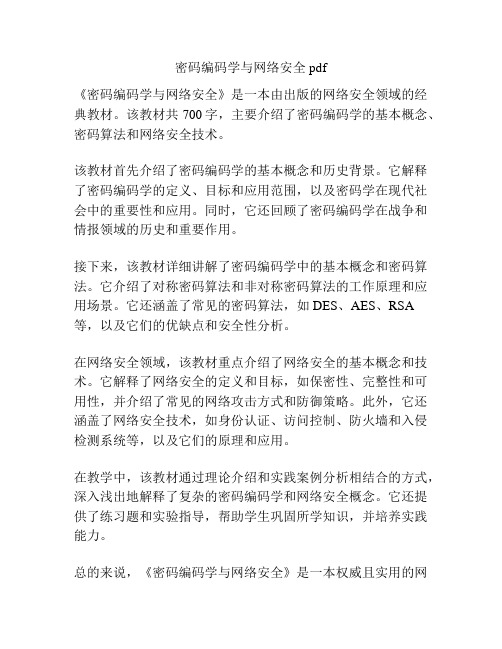
密码编码学与网络安全 pdf
《密码编码学与网络安全》是一本由出版的网络安全领域的经典教材。
该教材共700字,主要介绍了密码编码学的基本概念、密码算法和网络安全技术。
该教材首先介绍了密码编码学的基本概念和历史背景。
它解释了密码编码学的定义、目标和应用范围,以及密码学在现代社会中的重要性和应用。
同时,它还回顾了密码编码学在战争和情报领域的历史和重要作用。
接下来,该教材详细讲解了密码编码学中的基本概念和密码算法。
它介绍了对称密码算法和非对称密码算法的工作原理和应用场景。
它还涵盖了常见的密码算法,如DES、AES、RSA 等,以及它们的优缺点和安全性分析。
在网络安全领域,该教材重点介绍了网络安全的基本概念和技术。
它解释了网络安全的定义和目标,如保密性、完整性和可用性,并介绍了常见的网络攻击方式和防御策略。
此外,它还涵盖了网络安全技术,如身份认证、访问控制、防火墙和入侵检测系统等,以及它们的原理和应用。
在教学中,该教材通过理论介绍和实践案例分析相结合的方式,深入浅出地解释了复杂的密码编码学和网络安全概念。
它还提供了练习题和实验指导,帮助学生巩固所学知识,并培养实践能力。
总的来说,《密码编码学与网络安全》是一本权威且实用的网
络安全教材,适用于计算机科学、信息安全等专业的教学和学习。
它对于培养学生在密码编码学和网络安全领域的专业知识和技能具有重要意义,为学生进一步深入研究和实践网络安全提供了坚实的基础。
【网络安全】网络安全之密码学

【⽹络安全】⽹络安全之密码学前⾔⼀、密码学概述现代密码技术及应⽤已经涵盖数据处理过程的各个环节,如数据加密、密码分析、数字签名、⾝份识别、零知识证明、秘密分享等。
通过以密码学为核⼼的理论与技术来保证数据的机密性、完整性、可⽤性等安全属性。
机密性指信息不泄漏给⾮授权的⽤户、实体或过程;完整性指数据未经授权不能被改变,即信息在存储或传输过程中保持不被偶然或蓄意的删除、修改、伪造、乱序、重放、插⼊等操作所破坏;可⽤性是保证信息和信息系统可被授权实体访问并按需求使⽤的特性,即当需要时应能存取所需的信息。
这三个性质俗称CIA。
除CIA外,其他安全属性还包括不可否认性、认证性等。
密码系统的保密性不依赖于对加密体制或算法的保密,⽽依赖于密钥。
⼆、密钥体制的分类根据加密密钥与解密密钥的关系,密码体制可分为对称密码体制和⾮对称密码体制。
对称密码体制也称单钥或私钥密码体制,其加密密钥和解密密钥相同,或实质上等同,即从⼀个易推倒出另⼀个。
常见的对称密钥算法包括DES、3DES、IDEA、 AES、RC4等。
⾮对称密码体制⼜称双钥或公钥密码体制,其加密密钥和解密密钥不同,从⼀个很难推出另⼀个。
其中,⼀个可以公开的密钥,称为公开密钥,简称公钥;另⼀个必须保密的密钥,称为私有密钥,简称私钥。
典型的公私钥密码算法有RSA、DSA、DH、ECC和EIGamal等。
按明⽂的处理⽅式,可以将对称密码体制分为流密码和分组密码。
流密码也称为序列密码,是将明⽂消息按字符逐位地加密,连续的处理输⼊明⽂,即⼀次加密⼀个⽐特或⼀个字节。
分组密码是将明⽂按组分成固定长度的块,⽤同⼀密钥和算法对每⼀块加密,每个输⼊块加密后得到⼀个固定长度的密⽂输出块,典型的密码算法有DES、IDEA、AES、RC5、Twofish、CAST-256、MARS等。
三、密钥管理密码的种类繁多,⼀般可分为以下类型:初始密钥( primary key),⼜称基本密钥(base key),是由⽤户选定或系统分配的到的,可在较长的时间(相对会话密钥)内使⽤;会话密钥( session key)是通信双⽅在⼀次通话或交换数据时使⽤的密钥,可以由可信的密钥分发中⼼(KDC)分配,也可以由通信⽤户协商获得;密钥加密密钥(KEK)是对传输的会话或⽂件密钥进⾏加密的密钥;主机主密钥(host master key)是对密钥加密密钥进⾏加密的密钥,它⼀般保存在主机处理器中。
密码学与网络安全【英文】
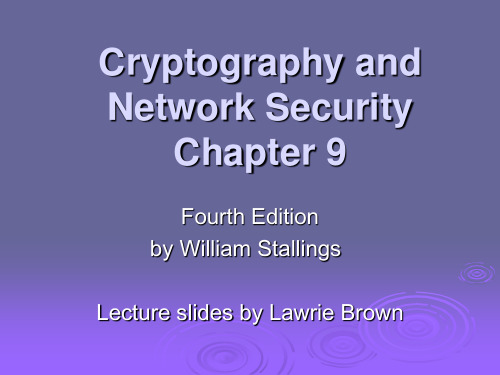
Private-Key Cryptography
traditional
private/secret/single key cryptography uses one key shared by both sender and receiver if this key is disclosed communications are compromised also is symmetric, parties are equal hence does not protect sender from receiver forging a message & claiming is sent by sender
Public-Key Cryptosystems
Public-Key Applications
can
classify uses into 3 categories:
encryption/decryption (provide secrecy) digital signatures (provide authentication) key exchange (of session keys)
some
algorithms are suitable for all uses, others are specific to one
Why Public-Key Cryptography?
developed
to address two key issues:
key distribution – how to have secure communications in general without having to trust a KDC with your key digital signatures – how to verify a message comes intact from the claimed sender
密码学原理及其在网络安全中的应用

密码学原理及其在网络安全中的应用密码学是一门研究如何保护信息安全的学科,它涉及到加密、解密和认证等方面的技术。
在当今信息爆炸的时代,网络安全成为了一个重要的议题。
随着互联网的普及,人们越来越依赖于网络进行信息传输和存储,因此,密码学的应用在网络安全中变得尤为重要。
本文将介绍密码学的基本原理以及它在网络安全中的应用。
一、对称加密算法对称加密算法是一种使用相同密钥进行加密和解密的算法。
在这种算法中,发送方和接收方必须事先共享密钥。
其中最常见的对称加密算法是DES(Data Encryption Standard)和AES(Advanced Encryption Standard)。
DES是一种使用56位密钥的对称加密算法,而AES则是一种更为安全的对称加密算法,它使用128位、192位或256位密钥。
对称加密算法的优点是加密和解密速度快,适用于大量数据的加密。
然而,由于发送方和接收方需要共享密钥,密钥的管理成为一个问题。
如果密钥被泄露,那么加密的安全性将受到威胁。
二、非对称加密算法非对称加密算法使用不同的密钥进行加密和解密。
这种算法包括公钥和私钥,公钥可以公开给任何人使用,而私钥则只能由接收方保管。
最常见的非对称加密算法是RSA(Rivest-Shamir-Adleman)算法。
非对称加密算法的优点是密钥的管理更为方便,不需要事先共享密钥。
然而,由于非对称加密算法的计算复杂度较高,加密和解密的速度相对较慢。
因此,在实际应用中,通常使用对称加密算法和非对称加密算法相结合的方式,即先使用非对称加密算法交换密钥,然后使用对称加密算法进行大量数据的加密。
三、哈希函数哈希函数是一种将任意长度的输入映射为固定长度输出的函数。
它具有单向性和抗碰撞性的特点。
单向性指的是通过哈希值无法逆向推导出原始输入,而抗碰撞性指的是不同的输入很难产生相同的哈希值。
哈希函数在网络安全中的应用非常广泛。
例如,数字签名就是使用哈希函数来确保数据的完整性和真实性。
密码编码学与网络安全课后习题答案全修订稿

密码编码学与网络安全课后习题答案全Document number【SA80SAB-SAA9SYT-SAATC-SA6UT-SA18】密码编码学与网络安全(全)什么是OSI安全体系结构?OSI安全体系结构是一个架构,它为规定安全的要求和表征满足那些要求的途径提供了系统的方式。
该文件定义了安全攻击、安全机理和安全服务,以及这些范畴之间的关系。
被动安全威胁和主动安全威胁之间的差别是什么?被动威胁必须与窃听、或监控、传输发生关系。
电子邮件、文件的传送以及用户/服务器的交流都是可进行监控的传输的例子。
主动攻击包括对被传输的数据加以修改,以及试图获得对计算机系统未经授权的访问。
验证:保证通信实体之一,它声称是。
访问控制:防止未经授权使用的资源(即,谁可以拥有对资源的访问,访问在什么条件下可能发生,那些被允许访问的资源做这个服务控制)。
数据保密:保护数据免受未经授权的披露。
数据完整性:保证接收到的数据是完全作为经授权的实体(即包含任何修改,插入,删除或重播)发送。
不可否认性:提供保护反对否认曾参加全部或部分通信通信中所涉及的实体之一。
可用性服务:系统属性或访问和经授权的系统实体的需求,可用的系统资源,根据系统(即系统是可用的,如果它提供服务,根据系统设计,只要用户要求的性能指标它们)。
第二章1.什么是对称密码的本质成分?明文、加密算法、密钥、密文、解密算法。
4.分组密码和流密码的区别是什么?流密码是加密的数字数据流的一个位或一次一个字节。
块密码是明文块被视为一个整体,用来产生一个相同长度的密文块......分组密码每次处理输入的一组分组,相应的输出一组元素。
流密码则是连续地处理输入元素,每次输出一个元素。
6.列出并简要定义基于攻击者所知道信息的密码分析攻击类型。
惟密文攻击:只知道要解密的密文。
这种攻击一般是试遍所有可能的密钥的穷举攻击,如果密钥空间非常大,这种方法就不太实际。
因此攻击者必须依赖于对密文本身的分析,这一般要运用各种统计方法。
密码编码学与网络安全_课后习题答案(全).doc
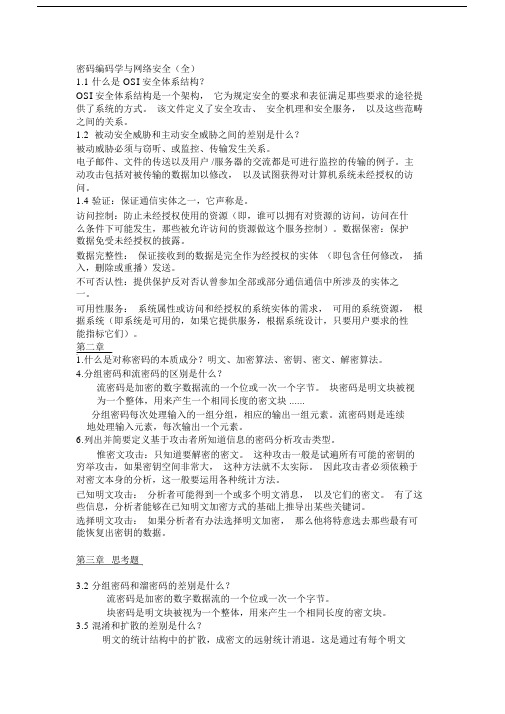
密码编码学与网络安全(全)1.1 什么是 OSI 安全体系结构?OSI 安全体系结构是一个架构,它为规定安全的要求和表征满足那些要求的途径提供了系统的方式。
该文件定义了安全攻击、安全机理和安全服务,以及这些范畴之间的关系。
1.2 被动安全威胁和主动安全威胁之间的差别是什么?被动威胁必须与窃听、或监控、传输发生关系。
电子邮件、文件的传送以及用户 /服务器的交流都是可进行监控的传输的例子。
主动攻击包括对被传输的数据加以修改,以及试图获得对计算机系统未经授权的访问。
1.4 验证:保证通信实体之一,它声称是。
访问控制:防止未经授权使用的资源(即,谁可以拥有对资源的访问,访问在什么条件下可能发生,那些被允许访问的资源做这个服务控制)。
数据保密:保护数据免受未经授权的披露。
数据完整性:保证接收到的数据是完全作为经授权的实体(即包含任何修改,插入,删除或重播)发送。
不可否认性:提供保护反对否认曾参加全部或部分通信通信中所涉及的实体之一。
可用性服务:系统属性或访问和经授权的系统实体的需求,可用的系统资源,根据系统(即系统是可用的,如果它提供服务,根据系统设计,只要用户要求的性能指标它们)。
第二章1.什么是对称密码的本质成分?明文、加密算法、密钥、密文、解密算法。
4.分组密码和流密码的区别是什么?流密码是加密的数字数据流的一个位或一次一个字节。
块密码是明文块被视为一个整体,用来产生一个相同长度的密文块 ......分组密码每次处理输入的一组分组,相应的输出一组元素。
流密码则是连续地处理输入元素,每次输出一个元素。
6.列出并简要定义基于攻击者所知道信息的密码分析攻击类型。
惟密文攻击:只知道要解密的密文。
这种攻击一般是试遍所有可能的密钥的穷举攻击,如果密钥空间非常大,这种方法就不太实际。
因此攻击者必须依赖于对密文本身的分析,这一般要运用各种统计方法。
已知明文攻击:分析者可能得到一个或多个明文消息,以及它们的密文。
有了这些信息,分析者能够在已知明文加密方式的基础上推导出某些关键词。
密码学与网络安全答案

密码学与网络安全答案
密码学是关于保护信息安全的学科,而网络安全是保护网络系统免受恶意攻击和未经授权访问的技术和措施。
保障信息安全和网络安全对于个人、组织和国家来说都非常重要。
密码学旨在通过使用密码算法来保护数据的机密性、完整性和可用性。
最常见的密码学方法包括对称加密和非对称加密。
对称加密使用相同的密钥对数据进行加密和解密,而非对称加密使用一对密钥(公钥和私钥)进行加密和解密。
密码学还涉及到其他技术,如散列函数和数字签名,用于验证数据的完整性和身份认证。
网络安全是指保护网络和网络设备免受未经授权访问、攻击和损害的过程。
网络安全包括防火墙、入侵检测系统、入侵防御系统、安全认证、访问控制和数据加密等措施。
此外,网络安全还涉及安全的网络架构、安全的操作系统和应用程序等方面。
密码学和网络安全紧密相关,密码学提供了保护数据机密性和完整性的技术,而网络安全则提供了保护整个网络系统的技术和措施。
在网络通信中,密码学被广泛应用于加密敏感信息,以防止未经授权的访问和数据泄露。
网络安全措施则提供了保护网络和网络设备免受攻击和未经授权访问的能力。
综上所述,密码学和网络安全在保护信息安全和网络系统安全方面起着重要作用。
它们的目标是确保数据的保密性、完整性和可用性,防止数据泄露、损坏和未经授权访问。
网络安全与密码学
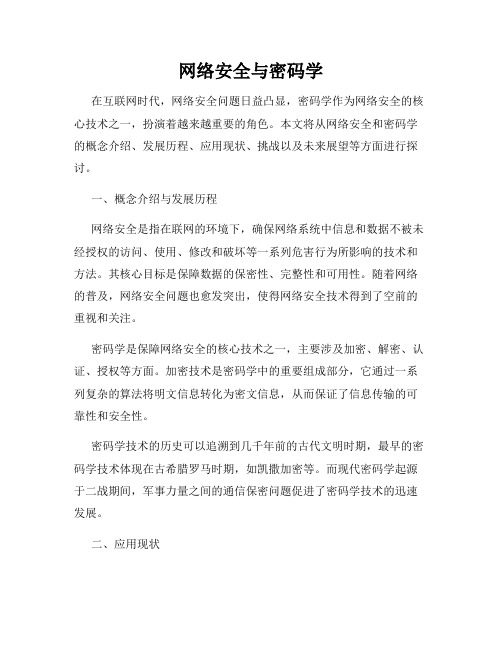
网络安全与密码学在互联网时代,网络安全问题日益凸显,密码学作为网络安全的核心技术之一,扮演着越来越重要的角色。
本文将从网络安全和密码学的概念介绍、发展历程、应用现状、挑战以及未来展望等方面进行探讨。
一、概念介绍与发展历程网络安全是指在联网的环境下,确保网络系统中信息和数据不被未经授权的访问、使用、修改和破坏等一系列危害行为所影响的技术和方法。
其核心目标是保障数据的保密性、完整性和可用性。
随着网络的普及,网络安全问题也愈发突出,使得网络安全技术得到了空前的重视和关注。
密码学是保障网络安全的核心技术之一,主要涉及加密、解密、认证、授权等方面。
加密技术是密码学中的重要组成部分,它通过一系列复杂的算法将明文信息转化为密文信息,从而保证了信息传输的可靠性和安全性。
密码学技术的历史可以追溯到几千年前的古代文明时期,最早的密码学技术体现在古希腊罗马时期,如凯撒加密等。
而现代密码学起源于二战期间,军事力量之间的通信保密问题促进了密码学技术的迅速发展。
二、应用现状密码学是当今信息安全领域主要的技术手段之一,各个领域都在广泛应用。
其中最常见的应用领域是银行、电商、社交平台、云计算等,它们都依赖于密码学的安全基础。
银行业是应用密码学技术最为广泛的行业之一,银行通过密码学技术来保护客户账号密码、支付密码等敏感信息的安全。
电子商务领域也需要依靠密码学技术确保交易和用户信息的机密性和完整性。
社交平台通过密码学技术保证用户账户、发布内容和聊天记录的安全。
云计算作为一个快速发展的领域,密码学也扮演着不可或缺的角色,在数据传输、存储和管理的过程中需要使用加密算法来保障数据的安全性。
三、挑战和未来展望随着信息化进程的不断推进,网络安全和信息安全问题正在日益复杂化和深化,以往的密码学技术在应对新的网络安全挑战时面临不足。
比如,在大数据环境下,传统的密码学算法难以满足高效性和实时性的需求;在物联网环境下,设备安全和数据隐私保护的问题仍然亟待解决。
密码学与网络安全

密码学与网络安全密码学是研究如何保护信息安全的一门学科,而网络安全是指在使用互联网时维护信息安全的一系列措施。
在当今数字化时代,密码学与网络安全的重要性越来越被人们所重视。
本文将介绍密码学的基本原理、常见的密码算法以及网络安全的相关措施和挑战。
一、密码学的基本原理密码学的基本原理是通过使用密码算法对信息进行加密和解密,以达到保护信息的目的。
密码学中的基本术语包括明文、密文、加密算法和解密算法等。
1.明文和密文明文是指未经过加密处理的原始信息,而密文是通过加密算法对明文进行加密后得到的加密文本。
密文通过使用相应的解密算法才能恢复为明文。
2.加密算法和解密算法加密算法是指将明文转化为密文的过程,而解密算法是指将密文恢复为明文的过程。
常见的加密算法包括对称加密算法和非对称加密算法。
3.对称加密算法对称加密算法是指加密和解密使用相同密钥的加密算法。
在对称加密算法中,发送方和接收方必须共享同一个密钥才能进行加解密操作。
常见的对称加密算法有DES、AES等。
4.非对称加密算法非对称加密算法是指加密和解密使用不同密钥的加密算法。
在非对称加密算法中,发送方使用接收方的公钥进行加密操作,而接收方使用自己的私钥进行解密。
常见的非对称加密算法有RSA、Diffie-Hellman等。
二、常见的密码算法1. DES算法DES(Data Encryption Standard)算法是一种对称密钥加密算法,使用56位密钥对明文进行加密,并生成64位的密文。
DES算法在数据加密领域应用广泛,但其密钥长度较短,易于被暴力破解。
2. AES算法AES(Advanced Encryption Standard)算法是一种对称密钥加密算法,使用128、192或256位密钥对明文进行加密。
AES算法被广泛应用于加密通信和数据存储领域,具有较高的安全性。
3. RSA算法RSA算法是一种非对称密钥加密算法,使用数论相关的数学原理,通过生成公钥和私钥来进行加密和解密操作。
密码学与网络信息安全

密码学与网络信息安全1.密码学概述1.1 密码学的定义和背景1.2 密码学的基本原理1.3 密码学的分类①对称密钥密码学②公钥密码学③哈希函数和消息认证码1.4 密码学在网络信息安全中的应用2.对称密钥密码学2.1 对称密钥密码学的基本概念2.2 对称密钥密码算法①数据加密标准(DES)②高级加密标准(AES)③国际数据加密算法(IDEA)2.3 对称密钥协商与管理①密钥交换协议②密钥管理机制3.公钥密码学3.1 公钥密码学的基本概念3.2 公钥加密算法① RSA算法②椭圆曲线密码算法(ECC)3.3 数字签名算法① RSA数字签名算法②数字签名与认证机构3.4 公钥证书和证书管理① X.509证书格式②证书颁发机构(CA)和证书链4.哈希函数与消息认证码4.1 哈希函数的定义与特性①哈希函数的安全性要求②常见的哈希函数算法4.2 消息认证码的概念与应用① HMAC算法②消息认证码在网络安全中的应用5.网络信息安全5.1 网络安全基础知识①威胁与攻击类型②网络安全防护措施5.2 网络通信的安全性保障①安全传输协议(SSL/TLS)②安全套接层与传输层安全性(SSL/TLS)的比较5.3 网络安全漏洞与威胁①漏洞扫描与漏洞利用②防火墙与入侵检测系统5.4 网络安全策略与管理①网络安全政策制定与实施②安全事件响应与处置附件:1.数据加密标准(DES)算法详细说明2.高级加密标准(AES)算法详细说明3.RSA算法的原理和应用4.椭圆曲线密码算法(ECC)详解5.HMAC算法的详细说明法律名词及注释:1.数据加密标准(DES):一种对称密钥加密算法,由美国联邦于1977年发布。
2.高级加密标准(AES):一种对称密钥加密算法,由美国国家标准与技术研究院于2001年发布。
3.公钥密码学:一种利用公钥和私钥进行加密与解密的密码学系统。
4.RSA算法:一种常见的公钥加密算法,基于数论问题的难解性。
5.椭圆曲线密码算法(ECC):一种基于椭圆曲线数学的公钥密码算法,具有高安全性和高效性的特点。
网络安全与密码学保障通信和数据的机密性与完整性
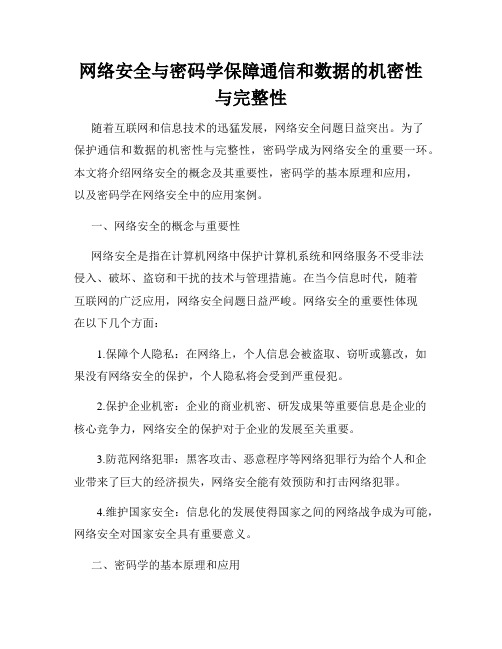
网络安全与密码学保障通信和数据的机密性与完整性随着互联网和信息技术的迅猛发展,网络安全问题日益突出。
为了保护通信和数据的机密性与完整性,密码学成为网络安全的重要一环。
本文将介绍网络安全的概念及其重要性,密码学的基本原理和应用,以及密码学在网络安全中的应用案例。
一、网络安全的概念与重要性网络安全是指在计算机网络中保护计算机系统和网络服务不受非法侵入、破坏、盗窃和干扰的技术与管理措施。
在当今信息时代,随着互联网的广泛应用,网络安全问题日益严峻。
网络安全的重要性体现在以下几个方面:1.保障个人隐私:在网络上,个人信息会被盗取、窃听或篡改,如果没有网络安全的保护,个人隐私将会受到严重侵犯。
2.保护企业机密:企业的商业机密、研发成果等重要信息是企业的核心竞争力,网络安全的保护对于企业的发展至关重要。
3.防范网络犯罪:黑客攻击、恶意程序等网络犯罪行为给个人和企业带来了巨大的经济损失,网络安全能有效预防和打击网络犯罪。
4.维护国家安全:信息化的发展使得国家之间的网络战争成为可能,网络安全对国家安全具有重要意义。
二、密码学的基本原理和应用密码学是研究如何借助密码以及相关技术来保护信息安全的学科。
它的基本原理包括对称加密和非对称加密。
1.对称加密:对称加密算法又称为私钥加密算法,发送方和接收方使用同一个密钥进行加密和解密。
常见的对称加密算法有DES、AES等。
优点是加密效率高,缺点是密钥的传输易受到攻击。
2.非对称加密:非对称加密算法又称为公钥加密算法,发送方使用接收方的公钥进行加密,接收方使用自己的私钥进行解密。
常见的非对称加密算法有RSA、ECC等。
优点是密钥的传输更加安全,缺点是加密效率较低。
除了对称加密和非对称加密,密码学还包括哈希算法和数字签名等技术。
哈希算法通过对数据进行不可逆的转换,保证数据的完整性和真实性;数字签名通过私钥对数据进行加密,接收方通过公钥对签名进行解密以验证数据的真实性。
密码学广泛应用于网络安全中,保障通信和数据的机密性与完整性。
网络安全密码学技术保障网络通信安全

网络安全密码学技术保障网络通信安全随着互联网时代的到来,人们的日常生活离不开网络通信。
在这个数字化时代,各种信息都通过网络进行传输。
然而,网络通信的安全性成为了一个重要的问题。
为了保障网络通信的安全,密码学技术在网络安全中起到了至关重要的作用。
一、密码学的定义和作用密码学是研究信息安全和数据加密的学科,它的主要目标是确保信息在传输和存储过程中不被未经授权的人获取和篡改。
密码学技术通过使用密码算法、密钥管理和身份验证等方法来实现信息的安全传输。
密码学技术在网络安全中的主要作用有:1. 保障数据的机密性:密码学技术通过加密算法对数据进行加密,使通信过程中的数据只有经过合法的解密才能被理解和使用。
2. 保证数据的完整性:密码学技术使用数字签名和消息认证码等方法,确保数据在传输过程中不被篡改。
3. 提供身份验证:密码学技术可以通过数字证书和数字签名等方式验证通信双方的身份,防止伪装和冒充。
4. 提供不可抵赖性:密码学技术可以通过数字签名等方法,确保信息的发送者不能否认自己曾经发送过某条消息。
5. 实现安全的密钥交换:密码学技术采用密钥交换协议来确保密钥的安全分发和交换,从而防止密钥被破解或泄露。
二、常见的密码学技术1. 对称加密算法:对称加密算法使用同一个密钥对数据进行加密和解密。
常见的对称加密算法有DES、AES等。
这些算法有着高效、快速的特点,在传输大量数据时非常实用。
2. 非对称加密算法:非对称加密算法使用公钥和私钥的组合对数据进行加密和解密。
公钥可以公开,而私钥只有拥有者知道。
常见的非对称加密算法有RSA、ECC等。
这些算法具有密钥安全性高的特点,适用于身份认证和密钥交换等场景。
3. 散列函数:散列函数是将任意长度的输入经过计算后生成固定长度的输出。
常见的散列函数有MD5、SHA-1、SHA-256等。
散列函数主要用于验证数据的完整性。
4. 数字签名:数字签名使用非对称加密算法和散列函数等技术,保证了数据的完整性和发送者的身份认证。
密码学与网络安全答案
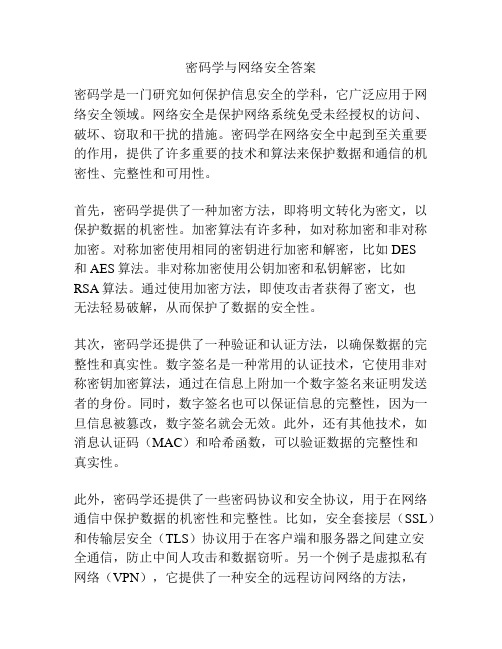
密码学与网络安全答案密码学是一门研究如何保护信息安全的学科,它广泛应用于网络安全领域。
网络安全是保护网络系统免受未经授权的访问、破坏、窃取和干扰的措施。
密码学在网络安全中起到至关重要的作用,提供了许多重要的技术和算法来保护数据和通信的机密性、完整性和可用性。
首先,密码学提供了一种加密方法,即将明文转化为密文,以保护数据的机密性。
加密算法有许多种,如对称加密和非对称加密。
对称加密使用相同的密钥进行加密和解密,比如DES和AES算法。
非对称加密使用公钥加密和私钥解密,比如RSA算法。
通过使用加密方法,即使攻击者获得了密文,也无法轻易破解,从而保护了数据的安全性。
其次,密码学还提供了一种验证和认证方法,以确保数据的完整性和真实性。
数字签名是一种常用的认证技术,它使用非对称密钥加密算法,通过在信息上附加一个数字签名来证明发送者的身份。
同时,数字签名也可以保证信息的完整性,因为一旦信息被篡改,数字签名就会无效。
此外,还有其他技术,如消息认证码(MAC)和哈希函数,可以验证数据的完整性和真实性。
此外,密码学还提供了一些密码协议和安全协议,用于在网络通信中保护数据的机密性和完整性。
比如,安全套接层(SSL)和传输层安全(TLS)协议用于在客户端和服务器之间建立安全通信,防止中间人攻击和数据窃听。
另一个例子是虚拟私有网络(VPN),它提供了一种安全的远程访问网络的方法,通过加密和隧道技术来保护数据和通信的安全。
除了上述的技术和方法,密码学还包括密码学分析和密码破解技术,以及密码理论的研究。
密码学分析是指破解密码算法和系统,以发现其弱点和漏洞。
密码破解技术是指尝试通过猜测、穷举和其他方法获取密码的过程。
密码理论则研究密码学的基本原理和概念,以及构建安全密码系统的方法和原则。
综上所述,密码学在网络安全领域起着重要的作用。
它通过提供加密、验证和认证技术,保护数据和通信的机密性、完整性和可用性。
密码学还提供了一些密码协议和安全协议,用于保护网络通信的安全性。
密码编码学与网络安全-原理与实践 课后答案
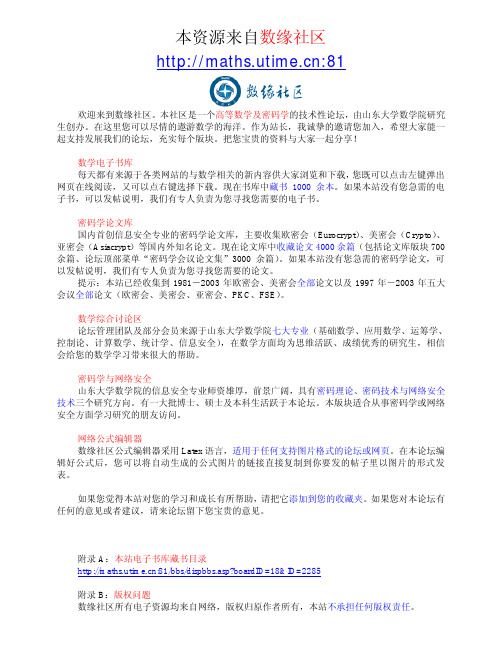
密码学与网络安全 山东大学数学院的信息安全专业师资雄厚,前景广阔,具有密码理论、密码技术与网络安全 技术三个研究方向。有一大批博士、硕士及本科生活跃于本论坛。本版块适合从事密码学或网络 安全方面学习研究的朋友访问。
Third Edition WILLIAM STALLINGS
Copyright 2002: William Stallings -1-
TABLE OF CONTENTS
Chapter 2: Chapter 3: Chapter 4: Chapter 5: Chapter 6: Chapter 7: Chapter 8: Chapter 9: Chapter 10: Chapter 11: Chapter 12: Chapter 13: Chapter 14: Chapter 15: Chapter 16: Chapter 17: Chapter 18: Chapter 19: Chapter 20:
附录 A:本站电子书库藏书目录 :81/bbs/dispbbs.asp?boardID=18&ID=2285
附录 B:版权问题 数缘社区所有电子资源均来自网络,版权归原作者所有,本站不承担任何版权责任。
SOLUTIONS MANUAL
CRYPTOGRAPHY AND NETWORK SECURITY
W.ห้องสมุดไป่ตู้.
-3-
CHAPTER 2 CLASSICAL ENCRYPTION TECHNIQUES
- 1、下载文档前请自行甄别文档内容的完整性,平台不提供额外的编辑、内容补充、找答案等附加服务。
- 2、"仅部分预览"的文档,不可在线预览部分如存在完整性等问题,可反馈申请退款(可完整预览的文档不适用该条件!)。
- 3、如文档侵犯您的权益,请联系客服反馈,我们会尽快为您处理(人工客服工作时间:9:00-18:30)。
Joint Entropy
When we have two probability sample spaces, S1 and S2, we can define the joint entropy H(S1, S2) as
H(S1, S2) =
ΣΣ P (x, y) × [log2 1/P (x, y)]
Hmin(S) = 0 bits
In other words, the entropy of every probability sample space has a lower limit defined by the above formula.
The entropy of a probability sample space is between 0 bits and log2 n bits, where n is the number of possible outcomes.
The above two examples show that there is a relationship between the usefulness of an event and the expectation of the receiver. If the receiver is surprised when the event happens, the message contains a lot of information; otherwise, it does not. In other words, the information content of a message is inversely related to the probability of the occurrence of that message. If the event is very probable, it does not contain any information (Example F.1); if it is very improbable, it contains a lot of information (Example F.2).
H(S) = Σ P(s) × [log2 1/P(s)] bits
where s ∈ S is the possible outcome of the experiment. Note that if P(s) = 0, then we let the corresponding term, P(s) × [log2 1/P(s)], be 0 to avoid dividing by 0. Example F.3
Example F.4
Assume that we toss a nonfair coin. The outcomes are heads and tails, with P(heads) = 3/4 and P(tails) = 1/4. This means H(S) = (3/4) × [log2 1/(3/4)] + (1/4) × [log2 1/(1/4)] ≈ 0.8 bit This example shows that the result of flipping a nonfair coin gives us only 0.8 bit of information (uncertainty). The amount of information here is less than the amount of information in Example F.3, because we are expecting to get heads most of the time; we are surprised only when we get tails.
Hmax(S) = log2 n bits
for70220_appF.fm Page 617 Saturday, January 27, 2007 1:09 PM
SECTION F.2
ENTROPY
617
In other words, the entropy of every probability sample space has an upper limit defined by this formula. Example F.6
Assume that we roll a six-sided fair die. The entropy of the experiment is H(S) = log2 6 ≈ 2.58 bits
Minimum Entropy
It can be proven that for a particular probability sample space with n possible outcomes, minimum entropy is obtained when only one of the outcomes occurs all the time. In this case, the minimum entropy is
for70220_appF.fm Page 615 Saturday, January 27, 2007 1:09 PM
APPENDIX F
Information Theory
In this appendix, we discuss several concepts from information theory that are related to topics discussed in this book.
Maximum Entropy
It can be proven that for a particular probability sample space with n possible outcomes, maximum entropy can be achieved only if all the probabilities are the same (all outcomes are equally likely). In this case, the maximum entropy is
Imagine a person sitting in a room. Looking out the window, she can clearly see that the sun is shining. If at this moment she receives a call (an event) from a neighbor saying, “It is now daytime,” does this message contain any information? It does not. She is already certain that it is daytime. The message does not remove any uncertainty in her mind.
F.1 MEASURING INFORMATION
How can we measure the information in an event? How much information does an event carry? Let us answer these questions through examples. Example F.1
Assume that we toss a fair coin. The outcomes are heads and tails, each with a probability of 1/2. This means H(S) = P(heads) × [log2 1/(P(heads))] + P(tails) × [log2 1/(P(tails))] H(S) = (1/2) × [log2 1/(1/2)] + (1/2) × [log2 1/(1/2)] = 1 bit This example shows that the result of flipping a fair coin gives us 1 bit of information (uncertainty). In each flipping, we don’t know what the outcome will be; the two possibilities are equally likely.
615
for70220_appF.fm Page 616 Saturday, January 27, 2007 1:09 PM
616
APPENDIX F
INFORMATION THEORY
F.2 ENTROPY
Assume that S is a finite probability sample space (See Appendix D). The entropy or uncertainty of S is defined as
Example F.2
Imagine a person has bought a lottery ticket. If a friend calls to tell her that she has won first prize, does this message (event) contain any information? It does. The message contains a lot of information, because the probability of winning first prize is very small. The receiver of the message is totally surprised.
Interpretation of Entropy
Entropy can be thought of as the number of bits needed to reample space when the outcomes are equally probable. For example, when a probability sample space has eight possible outcomes, each outcome can be represented as three bits (000 to 111). When we receive the result of the experiment, we can say that we have received 3 bits of information. The entropy of this probability sample space is also 3 bits (log2 8 = 3).
